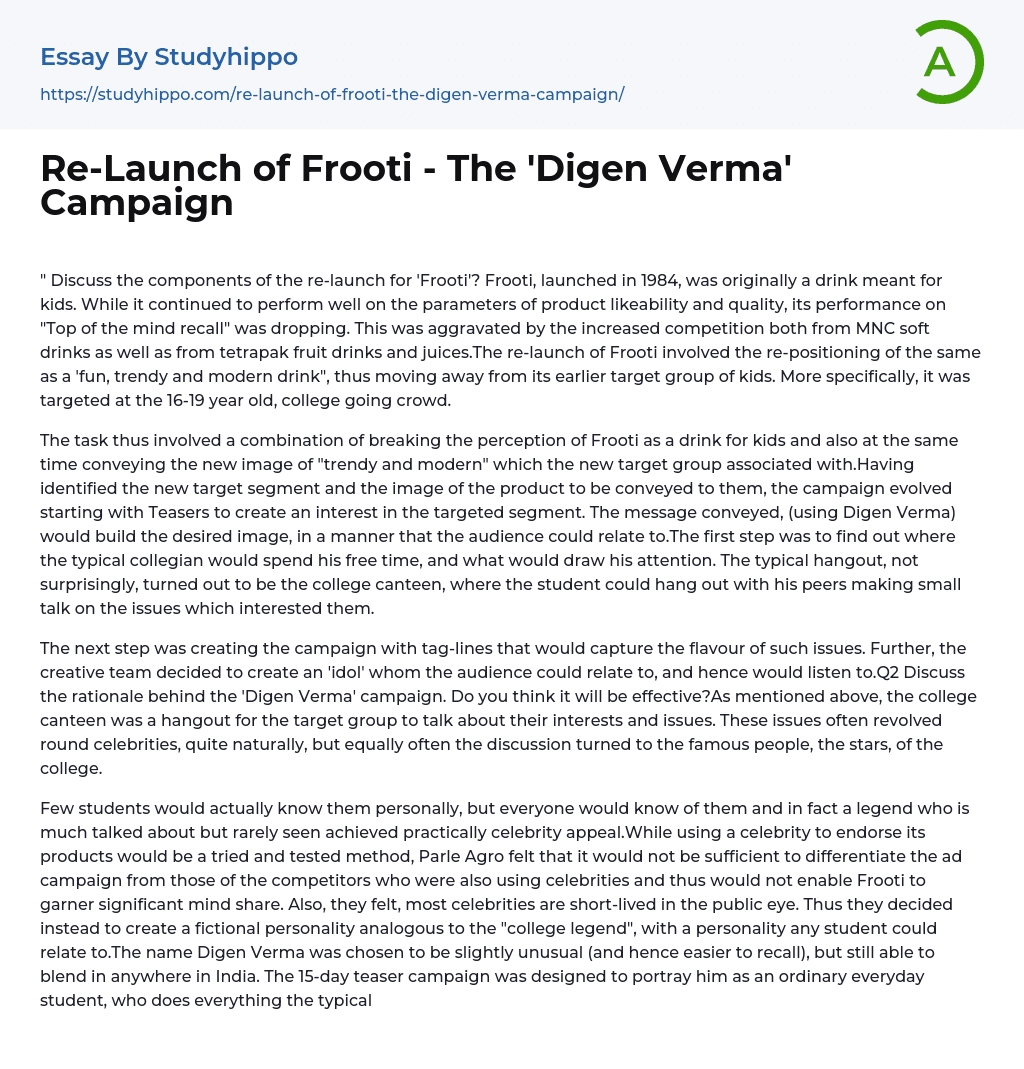

Re-Launch of Frooti – The ‘Digen Verma’ Campaign Essay Example
Discuss the relaunch of 'Frooti' and its components. Originally launched in 1984 as a drink for children, Frooti maintained good performance in terms of product likability and quality. However, it experienced a decline in "Top of the mind recall."
The increased competition from both MNC soft drinks and tetrapak fruit drinks and juices exacerbated the situation. To re-launch Frooti, its target audience was shifted from kids to the 16-19 year old college-going crowd. The goal was to break the perception of Frooti as a drink for kids and establish it as a trendy and modern drink appealing to the new target group. The campaign started with Teasers to generate interest among the targeted segment. Digen Verma was used to convey the desired image that the audience could relate to. The first step was to identify where the typical collegian would spe
...nd their free time and what would catch their attention. It was found that the college canteen was the typical hangout where students could engage in small talk on topics of interest.
To further the campaign, the team decided to create catchy tag-lines that captured the essence of the issues at hand. They also introduced an 'idol' character named Digen Verma, in order to connect with the audience and increase their likelihood of listening. The rationale behind the 'Digen Verma' campaign was discussed in question 2.
The college canteen served as a popular gathering spot for the target group to discuss their interests and concerns, often focusing on both local and national celebrities. While many students were not personally acquainted with these famous individuals, they were aware of their fame and status.
While using celebrity endorsements wa
a common tactic, Parle Agro believed it would not be enough to set their ad campaign apart from competitors who also employed celebrities. This approach did not effectively capture significant mind share for Frooti.
With the aim of resonating with students, a fictional character named Digen Verma was created to serve as both an ordinary college student and an inspiration for the fashionable youth. The intention behind this portrayal was to ensure that Frooti's target audience would easily remember Digen. Despite costing Rs 30 million, the campaign achieved impressive reach. Nevertheless, the success of the teaser campaign also raised considerable expectations.
There are two main challenges for the brand. First, it must meet the expectations of the new target group. Second, it must not disappoint the audience who were captivated by the teasers. Although Digen Verma fulfilled his role successfully, removing him could create a difficult void to fill. This situation could be similar to 7 UP's experience after ending the Fido Campaign, where sales were negatively impacted during a "blank period." It is crucial to recognize that a brand's success depends on factors beyond just its promotional campaign.
Creating a brand is a lengthy process that involves establishing expectations for the behavior of the brand, aligning with its core values. In essence, branding aims to create predictability, where the actions of the brand today can be used to anticipate its future actions. In contrast, promotion is inherently short-term and urgent in nature.
Promotions, whether they be advertisements, price reductions, larger packaging, tie-ins with other products, coupons, or other incentives, are all temporary. If not properly planned and executed, promotions can potentially harm a brand. The Digen Verma campaign
is an example of this. Some analysts believed that the name Digen Verma may overshadow the Frooti brand, suggesting that the promotional campaign did not help the brand as much as it should have. Additionally, a section of the target audience expressed disappointment when they discovered that it was a promotional campaign for Frooti, indicating a disconnect between the brand image and the promotional campaign. Consistency is crucial for brands. This means not only having promotions that deliver consistent messages but also starting with a well-defined brand that is relevant to the market.
Having a logo/tagline is not enough to complete the branding process. The process does not even begin without considering key brand elements such as positioning, promise, personality, and associations. Once a relevant brand is developed and defined, brand building should start with employees, customers, prospects, partners, etc. It should involve consistent execution in terms of delivering consistent quality, availability, or serviceability. Repetition is crucial for the success of the branding process. No one, including employees working for the brand, will truly know or remember what a brand is unless it remains the same every time they encounter it.
Without consistency, brand identification becomes unattainable regardless of the amount of money invested in marketing.
- Wal-Mart essays
- Discover essays
- Brand Equity essays
- Branding essays
- Nike, Inc. essays
- Market share essays
- Razor essays
- Advertising campaign essays
- Sales Promotion essays
- Advertisement essays
- Advertising essays
- Anheuser-busch essays
- Audience Theory essays
- Brand essays
- Brands essays
- Competitor Analysis essays
- Consumer essays
- Detergent essays
- Marketing Management essays
- Marketing Mix essays
- Marketing Plan essays
- Marketing Research essays
- Marketing Strategy essays
- New Product Development essays
- Point Of Sale essays
- Price essays
- Procurement essays
- Product essays
- Product Differentiation essays
- Product Placement essays
- Promotion essays
- Promotion And Marketing Communications essays
- Research Design essays
- Retailing essays
- Trademark essays
- Board Of Directors essays
- Brand Management essays
- Business Ethics essays
- Business Management essays
- Change Management essays
- Comparative Analysis essays
- Decision Making essays
- Dispute Resolution essays
- Knowledge Management essays
- Leadership essays
- Leadership and Management essays
- Manager essays
- Operations Management essays
- Performance Management essays
- Product Management essays



